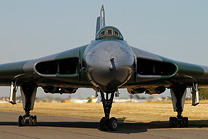April Update
Tuesday 9th April 2013
April is shaping up to be an extremely busy month for our events team, which we hope will prove to be well worthwhile in raising much needed funds towards the work on XL426. It kicks off with our AGM on 13 April at Hawkwell Village Hall, Essex, starting at 12 noon and which is open to VRT members and the general public. Being the Trust's AGM we cannot charge entry for this event as it is a part of the charity regulations regarding the operation of the VRT, and indeed the event will start with various items of the Trust's functions and financing. Members get free entry so as to vote and comment where necessary. The public are welcome to attend, and we hope that they will be happy to make donations of around £5 at the door, especially as the AGM section will be followed by a presentation by Squadron Leader Joe Marsden covering the Avro Vulcan and English Electric Canberra. Joe served on both aircraft during his 29-year RAF career and he will be describing what each of the iconic post-war British bombers was like to fly. Joe served with 27 and 617 Squadrons flying the Vulcan – including our own XL426 - before joining 7 Squadron where he flew various marks of the Canberra.
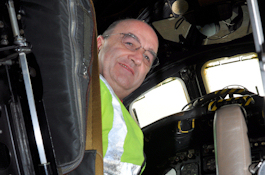
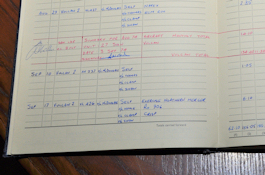
Above: Squadron Leader Joe Marsden and XL426 in his logbook.
Joe joined the RAF in 1971 and on completion of his training was posted to RAF Scampton, near Lincoln, flying the Vulcan in the maritime reconnaissance role. He was later posted to 617 Squadron, also at Scampton, who operated the Vulcan as bomber aircraft in support of NATO. Following his two Vulcan tours, Joe then converted to the Canberra, joining 7 Squadron at RAF St Mawgan, Cornwall, flying the B2, T4, TT18 and T19 versions of the aircraft. He later moved to RAF Finningley, near Doncaster, where he flew the Dominie and Jetstream. At this time he began a series of training and office postings, first as a ground instructor at the School of Air Navigation at Finningley, with further postings including a tour in the Falkland Islands. Joe's final tour before leaving the RAF in 2000 was as Chief Designer in the Mission Support Wing at RAF Waddington, near Lincoln, overseeing the operational software for the Boeing E-3D AWACS aircraft. Joe now works for the NATO Communications and Information Agency (NCIA) as a consultant on international air defence programmes.
What promises to be an interesting and exciting afternoon begins with the doors opening at 12 noon. Our Annual General Meeting will start at 1.00 p.m. and we estimate that Joe's talk with start around 2.00 - 2.15 p.m. The afternoon will finish at 5.00 p.m. Hawkwell Village Hall can be found on Main Road, Hawkwell, Hockley, Essex - the post code for Sat Nav users is SS5 4EH. We will have a licensed bar and teas, coffees and light snacks will be available. Our souvenir stall will be on hand to cater for all your Vulcan memorabilia needs!
Following that we are delighted to announce that the latest in our series of successful evening events at the Orsett Hall Hotel is to be a presentation by the Breitling Wingwalkers team on 17 April. The team have just returned from displaying in Australia having also been to China in late 2012, both of which have been great logistical tests for the small Aerosuperbatics-operated team from their base in the Cotswolds. Aerosuperbatics have been specialists in display flying for over 27 years and operate one of the best known and loved civilian air display acts in Europe. Previously sponsored by the likes of Utterly Butterly, Crunchie and Guinot, the team are now titled The Breitling Wingwalkers and are busier than ever. The wing walking team has performed at over 2500 different events, and are seen live by over 6 million spectators each year in the UK alone. The girls perform a sequence of acrobatic manoeuvres and handstands strapped to the top wings of the team's Boeing Stearman biplanes whilst the aircraft are flown through a well rehearsed energetic routine of aerobatics and close formation flypasts. These manoeuvres include loops, rolls, stall turns and even inverted flight. During all of this, the wing walkers experience speeds of up to 150 mph and 'G' forces of up to 4G.Currently sponsored by timepiece manufacturers Breitling the team can offer as many as four orange painted bi-planes to display organisers, although generally they are split into two pairs who will perform at different locations around the UK, Europe and beyond. The team draws on their teams of six pilots and six wing-walking girls to fulfil their busy display schedule and to represent them we are pleased to have lead pilot Dave Barrell and wingwalker Danielle Hughes visiting to share their experiences.
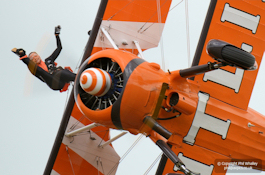
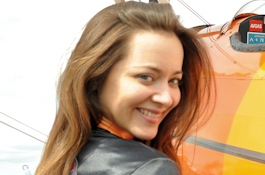
Above: Danielle Hughes of the Breitling Wingwalkers.
As a child growing up near Duxford airfield Dave saw many airshows and warbird aircraft were a common sight in the skies during the summer months. It was the combination of watching vintage aircraft flying overhead and a back seat ride in a Harvard that first gave him the incentive to learn to fly and he eventually gained his Pilot's Licence at Cambridge Aeroclub in 1995, initially cutting his teeth flying a parachute jump aircraft in East Anglia. It was at Swanton Morley airfield in Norfolk that Dave came across the Stearman on which he quickly built his 'tail dragger' hours and soon gained a Display Authorisation. He wanted to fly wing walking aircraft after seeing the Aerosuperbatics Team perform many years ago, and, after answering an advertisement, was selected for the team at the beginning of 2007. Dave soon became a 'formation lead' pilot with the team.
Danielle has been dreaming of becoming a wing lady from the tender age of 6 after her parents took her to a local airshow for the first time. It was there she experienced the sheer spectacle of the glamorous wing walkers in action on top of their colourful vintage biplane aircraft. This greatly inspired her and she now had a burning ambition to wing walk that she was determined to achieve. She has always been an active person and she really likes a challenge in life, especially if there is a competitive element to it. At the age of 14, she became the then national Tae Kwon Do Black Belt Second Dan British Champion! She likes to keep her fitness up in her spare time by jogging and going to the gym. Danielle loves every aspect of the wing walking display routine. She particularly enjoys the thrill of climbing around the aircraft in flight! These position changes happen at various points during the display and require a lot of physical strength to achieve. As if this wasn't difficult enough, she is often working against a 100 mph winds at the same time as the aeroplane is moving through the air! Her favourite manoeuvre of this type is known as the 'Arabesque'. This is where she will stand on the rear aeroplane cockpit and face the crowd waving at the same time! This happens at the end of the show just as she returns into the aircraft for landing.
Just when you thought there was no end to her talents, Danielle has recently gained her flying licence herself! Her next goal is to become a military pilot! Watch this space… The team pilots are now quaking in their boots as they're convinced she's eventually going to be after their jobs!
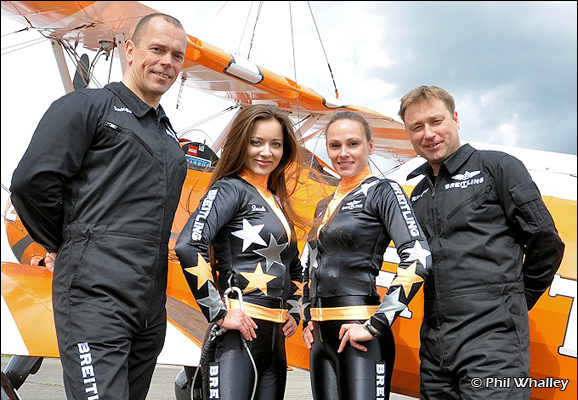
The Aerosuperbatics Breitling Wingwalkers Team
Tickets cost £10.00 each and can be purchased on line (subject to booking fee) from the Vulcan Restoration Trust website. Tickets will also be available on the door subject to availability. The evening is a special fundraising evening on behalf of the Vulcan Restoration Trust and all proceeds will go towards the ongoing restoration and preservation of Avro Vulcan XL426 at Southend Airport. The Orsett Hall Hotel has a licensed bar which will be open from doors opening at 7.00 p.m. through to the start of the Breitling Wingwalkers talk, and then during a comfort break. Our stand will also be in attendance, selling a selection of Vulcan souvenirs and memorabilia. We anticipate the event will finish at 10.00 - 10.15 p.m. There is ample car parking space at the Orsett Hall Hotel.
After these indoor events we are really hoping that the weather will improve before our first 'Visit the Vulcan' of 2013! We will be holding four Visit the Vulcan Days in 2013, the first taking place on Sunday 28 April. The other dates are: 16 June, 11 August and 29 September.
Our Visit the Vulcan Days are extremely popular with enthusiasts and the general public alike. Visitors will have the chance to get a close-up look at XL426 and climb on board to get to see inside the Vulcan's cramped cockpit. Members of the VRT Team will be on hand to give guided tours of the aircraft, and lunches and liquid refreshments will be available from the nearby Lancaster Bar and Restaurant. Gates open at 10.00 a.m. on each day with last admission being at 4.00 p.m. Entry will be on the same basis as at our Visit the Vulcan Days in previous years - general admission (£2.50 adults; free for accompanied children under-16) will allow visitors entry to the Vulcan parking area so they can walk around the aircraft, take a guided tour if they wish, and of course take photographs. An additional fee of £2.50 each for adults and children will buy visitors entry to XL426's cockpit. Cockpit visits are done on a timed ticket basis, so visitors do not have to stand and queue for entry. VRT Members will be entitled to free admission, including free entry to the cockpit. We encourage visitors to arrive by train wherever possible. London Southend Airport station is only three minutes walk from the Vulcan and is served by frequent trains on the London Liverpool Street to Southend Victoria line. The ample airport car parking runs on a pay and display system. Our souvenir stand will be open at each Visit the Vulcan Day selling a selection of Vulcan souvenirs, including badges, patches, photos, postcards, books, t-shirts and much more. If you can't wait to buy your souvenirs, you can purchase now via our on-line shop - please pay it a visit at http://shop.avrovulcan.com/. Sorry - no dogs can be admitted except assistance dogs.
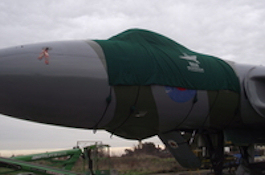
Work on XL426 has continued throughout the winter, in all weathers, whenever possible. Saturday 5 January was a dedicated 'care and maintenance' day with our Engineering Team busy going round XL426 with various greases and lubricating all the grease points. This is a vital task to keep all the moving parts and joints in good running order. It is also a very useful exercise for our newer engineers, as it's a good way of learning about parts of XL426 that they might not have come into contact with previously. The parts of the aircraft that were lubricated included the undercarriage legs, elevon bearings, the bomb bay doors and the rams and bearings housed within the bomb bay itself. The opportunity was also taken to grease all our ground equipment, including the ground power unit. This is just as vital as the work done on the aircraft, as without fully functioning ground equipment, working on XL426 will be difficult if not impossible. Power was kept on the aircraft all day and the Engineering Team exercised all the systems to keep them in good running order. XL426 was 'hooked up' to our hydraulic rig so she could be brought up to full hydraulic pressure. We use the rig as the only other way to get full pressure on the aircraft is to actually run her engines. With the rig running, we were able to open and close XL426's bomb doors, checking that they opened and closed in their normal time The middle two weekends of January saw our Engineering Team busy at both Southend Airport and at our workshop. Work renovating our air start unit continued whilst repairs to XL426's Powered Flying Control Unit (PFCU) control panel progressed. We also took delivery of a new canopy cover which looks very smart and features our logo. It will play an important role protecting XL426 during the winter months. Also of vital importance to the operation of the aircraft is the condition of the ground equipment, and this has been a focus of much recent work. Engineers Tony Kitson and Elliot Goddard replaced part of the air start unit's canopy and removed corrosion from the canopy area. Engineer Steve Harvey began the rather unwelcome task of removing the old paint from the air start hose assembly. Engineer Dougie Webb was also busy shot-blasting the components which make up the air start's brake assembly. The ongoing restoration of XL426's PFCUs took a step forward with lead engineer Paul Hartrup beginning to put No.3 PFCU back together. Some further 'tweaking' will be needed but the unit should back on XL426 in the not too distant future.
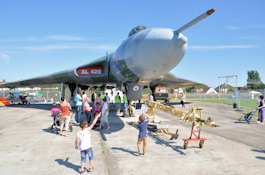
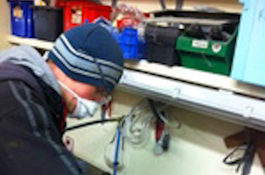
Above: Restoration work continues and you can help by supporting our events.
At the airport, lead engineer Andy Wagstaff and engineer John Palmer were hard at work repairing the PFCU control panel. The team have had trouble with PFCU warning lights not showing, and Andy and John have taken the panel apart and replaced or fixed broken wires and switches. This is a time consuming job and has put Andy and John's eyesight to the test reading the small writing on the manual's wiring diagrams. A trial re-fit of the panel at the end of the first Saturday saw 90% of the lights working, and work will continue until all are functioning correctly.
All of this vital work cannot continue without the help of the public either joining the Trust, attending our events or donating , so please consider a trip to see us at London Southend Airport or coming to one of our indoor events. We are also always on the look-out for additional volunteers on both the engineering and administration teams.
Please have a look at our website Vulcan Restoration Trust website for further details. Thank you.
Visit our forums to comment on this post.
50 Years Young
Friday 5th October 2012

We finally held our first Visit the Vulcan Day of 2012 on 22 July, a second on 26 August and a third on 30 September - the first public events we had held since the opening of the new passenger terminal at London Southend Airport and the start of regular scheduled flights by easyJet and Aer Arann. Much stricter rules governing airside access are now in place at the airport, meaning that our previous open day format would not be acceptable. After discussions with the airport management as to how and whether the Trust could continue to hold these events - which are vital sources of income - we are now required to erect Heras fencing to create a secure compound extending from the Lancaster Bar airside access gate across to, and around, XL426's pan. We have purchased 80 fencing panels to do this and took delivery of them on the Friday morning before the first Visit the Vulcan Day. The panels go up on Friday afternoon and Saturday morning, prior to the secure area being 'signed off' by Southend Airport security. The fencing is taken down on Sunday evening and the process repeated for all future public open days. Our visitors get a close-up view of XL426 and see the progress we have made repainting the aircraft. Our ever-popular cockpit visits see young and old alike experience at first hand the tight confines and hot conditions in which in which the Vulcan crews had to work. Also on display to the public for the first time is XL426's life raft which we have held in store for the last 15 years. The raft was damaged when it accidentally inflated inside XL426's cockpit whilst being removed from its stowage position (which is at the rear of the cockpit canopy) in the 1990s. The raft has now been repaired by a local company (although not to sea worthy condition) and it attracts a great deal of attention during the day. XL426's life raft dates back to 1973 and could happily hold a full five-man Vulcan crew, although it's doubtful XL426's crew would have been particularly happy if they'd ever had to use it! On display next to the life raft is a selection of original items from the air crew Personal Survival Pack, including a baler and leak stopper for the raft itself, a first aid kit, flying rations and compass. The display was compiled by Engineering Team member, Matt Isaac.
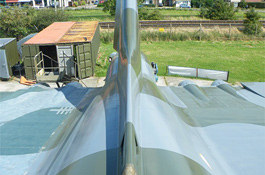
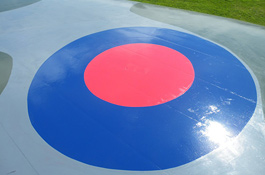
Above: The spine of XL426 painted, as is the port roundel.
The open days give the public the chance to see the continuing repainting of XL426 - the third of its time at Southend - which started in 2011 but stalled to some extent due to the inclement weather and the re-organisation of the team's infrastructure at the airport due to the loss of the Trust's workshop and stores building, bulldozed and tarmaced over to create one of the new car parks. Work is progressing at a pace. One team is carrying out the preparation whilst another follows up with the painting. The preparation work involves the use of DA sanders to remove any loose paint and then the area is given a thorough clean down with rag and panel wipe giving a good surface for painting. The tail and spine where painted first before work started on the wings with the fin flash being hand painted. The team opted for a vinyl decal for the XL426 serial. Other engineering work has involved the fuel tanks and continuing the seemingly never-ending servicing of powered flying control units. Two major mile-stones have been achieved in the first half of 2012; that being the re-fitting of the numbers three and four elevons and a slow speed taxi run. XL426 is gradually 'returning to power'.
On 23 August 2012 members of the VRT team gathered at London Southend Airport to celebrate fifty years since XL426's maiden flight.
Thursday 23 August 1962 saw XL426 take-off for the first time on a shakedown test-flight from the A V Roe & Co. airfield at Woodford, Cheshire. The flight lasted one hour and 35 minutes. XL426 made four further test flights before being delivered to 83 Squadron at RAF Scampton, Lincolnshire, on 12 September. XL426 was the 44th of the 88 Vulcan B2 bombers that were built.
The Scampton Wing (Nos. 27, 83 and 617 Squadrons) were at the time in the process of equipping with the Blue Steel stand-off missile. From September 1961, all aircraft delivered to these squadrons were specially modified to carry the new weapon, which was loaded, semi-recessed, in the Vulcan's bomb-bay.
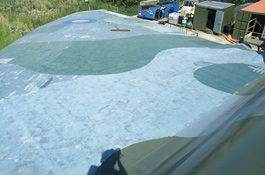
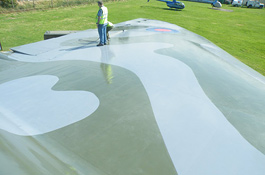
Above: Starboard wing rubbed down and prepped for painting, whilst the port receives finishing touches.
In December 1962, Wing Commander (later Group Captain) John Slessor took over command of 83 Squadron from Wing Commander (later Air Commodore) Ray Davenport. John Slessor selected XL426 as his personal aircraft for his three-year tour, and she proudly bore the squadron commander's pennant painted below her cockpit. On September 10th, 1963, whilst returning from Goose Bay, Canada, John Slessor flew XL426 to RAF Scampton in 4 hours 5 minutes - an unofficial record, pre-Concorde, for a crossing of the North Atlantic at that time.
In April 1964, the centralised servicing was introduced at RAF Scampton, meaning aircraft were no longer assigned to individual units, but instead were 'pooled' and assigned to squadrons on a day-by-day basis. XL426 was flown by all three squadrons of the Scampton Wing, which was now fully operational with Blue Steel. With the transfer of the nuclear deterrent role to the Royal Navy in 1969, Blue Steel was withdrawn and the Scampton squadrons were assigned to the tactical nuclear and conventional bombing roles.
Individual unit allocations were resumed in January 1971, and for the next 10 years, XL426 spent most of her time with 617 Squadron, although she also had brief spells with 27 Squadron and 230 Operational Conversion Unit, which had moved to RAF Scampton from RAF Finningley in December 1969.
In 1981, XL426 had the dubious distinction of being the 298th and last Vulcan to undergo a major service at RAF St Athan. Completion of the service was marked with a formal hand-over ceremony at which Air-Vice Marshal Richardson, RAF Support Command, and RAF Waddington's Commanding Officer, Group Captain Warrington, both signed for the aircraft. Also present was Warrant Officer John 'Bob' Shillings, one of XL426's first crew chiefs when she had entered service with 83 Squadron back in 1962.
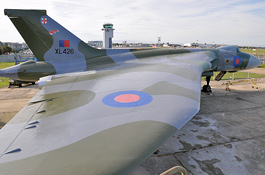
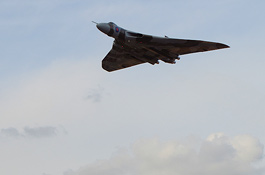
Above: Freshly applied 50 Sqn. greyhounds, and XH558 visits for her sister's birthday.
617 Squadron disbanded at the end of 1981 and XL426 was transferred to 50 Squadron at RAF Waddington, making the short flight south to join her new unit on January 4th, 1982. 50 Squadron became the last Vulcan squadron, operating six aircraft as air-to-air tankers until the Vulcan was finally withdrawn from operational service in 1984. XL426 was not converted to a tanker, but was one of three Vulcans retained by the squadron as a B2 to act as a crew trainer, helping to take some of the weight of flying off the shoulders of the already overstretched tankers. She had also been used as a trials aircraft as part of the Vulcan tanker test programme in 1982. XL426 was one of four Vulcans that took part in the Falklands Victory Flypast over London on October 12th, 1982 (although XL426 herself had not played an active role in the war itself). On March 30th, 1984, XL426 had the ultimate accolade of performing 50 Squadron's last display, in the hands of Squadron Leader Joe L'Estrange, at the squadron's disbandment ceremony at RAF Waddington.
Withdrawal of the Vulcan from operational service did not, however, spell the end of XL426's flying days. Very much aware of the Vulcan's tremendous public relations appeal, and already committed to a number of air displays appearances in the upcoming 1984 season, XL426 was kept airworthy (along with XH560 in reserve) for air display purposes. The two aircraft formed what became known as the Vulcan Historical Flight (later the Vulcan Display Flight - VDF), staffed initially entirely by volunteers. Under the command of Squadron Leader (later Group Captain) Bill Burnett, the Flight and XL426 gave their first display at No IX Squadron's Standard Presentation Parade at RAF Honington on May 23rd, 1984.
The Flight went on to give more than 50 displays during the course of the 1984 season, and it was agreed to continue displaying XL426 into 1985. As the 1985 season progressed, a close eye was kept on XL426's flying hours, as the time when she would require another major service was rapidly approaching. Plans were put in hand to replace her with another aircraft and, eventually, a replacement aircraft -XH558 - was found (retrieved from the fire dump at RAF Marham) and XL426 gave her final display at the RAF Coningsby Open Day on June 14th, 1986.
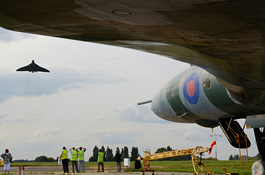
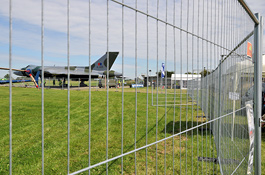
Above: VRT team members enjoying the visit of XH558. A view of the Heras fencing which has to be erected for each 'Visit' day.
The VMFSC took over ownership of XL426 in July 1993 and subsequently re-formed as a registered charity, the Vulcan Restoration Trust.
XL426 was put up for sale during the summer of 1986 and agreement was reached with a French consortium for her purchase. Meanwhile, the VDF was temporarily relocated to RAF Scampton to allow runway resurfacing to take place at Waddington, XL426 making the short flight back to her former home on July 27th. The French deal subsequently fell through and XL426 was sold to Roy Jacobsen, who had purchased another Vulcan (XM655) two years earlier. XL426 was delivered to her new owner at Southend Airport on December 19th, 1986, following a 20 minute flight from RAF Scampton. On arrival at Southend, XL426 had amassed 6236 hours flying time, having made over 1800 separate flights.
Roy Jacobsen had ambitious plans to operate XL426 as a civilian display aircraft, under the auspices of an organisation he had formed called the Vulcan Memorial Flight. XL426 was entered onto the British civil aircraft register as G-VJET and approaches were made to a number of potential sponsors. However, the sums required to carry out the necessary servicing work and finance the aircraft's ongoing operation could not be found and XL426 remained dormant at Southend. In 1990, local enthusiasts formed the Vulcan Memorial Flight Supporters Club (VMFSC) to help promote Mr Jacobsen's continuing efforts to return XL426 to the air, and to also take care of the aircraft's continued preservation.
As part of the day's celebrations the 617 Squadron badge was applied to the port side of the fin and unveiled in the presence of Sqn Ldr Chris Ball, representing the current 617 Sqn RAF which operates Panavia Tornado GR4 bombers from RAF Lossiemouth. Sqn Ldr Ball - known as 'Ballsy' - served with 617 Sqn for two and a half years, which included two tours to Afghanistan. 617 Squadron's most famous operation was that of the World War II dams raids of May 1943 - whilst flying the Vulcan's forebear the Avro Lancaster - and the Squadron badge depicts a stylised version of a breached dam.
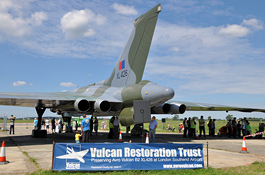
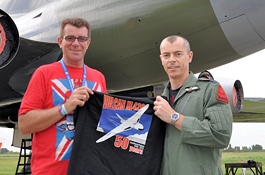
Above: Visiting public get the guided tour of XL426. Steve Barnes and 'Ballsy' exhibit a 50th birthday T-Shirt.
Also making an appearance on the Thursday of the anniversary was sister Vulcan B2 XH558 which flew overhead at Southend having displayed at the Clacton airshow. As described previously XH558 superseded XL426 in the air display role for the RAF before it too was sold into private hands. Vulcan XH558 was crewed by Kevin Rumens, Phill O'Dell and Barry Masefield.
Dave Griffiths, Trustee of Vulcan Restoration Trust writes:
"Still sitting here at Southend Airport. Stunned.
Two missed approaches and a climb out over '426 which made more than a few a little tearful. It was a wonderful salute to our dear XL426 and everyone at the Vulcan Restoration Trust would like to thank Kev, Phill and Barry for putting XH558 through her paces so spectacularly and everyone at Vulcan To The Sky for the immeasurable pleasure they bring to so many. Best of luck for the rest of the season, next year and maybe beyond. Many thanks from a blissfully happy Southend.
Regards,
Dave Griffiths."
The Vulcan Restoration Trust have produced a number of souvenir items celebrating XL426's 50 years which are available from the online store section of the Trust's website - www.avrovulcan.com - and will be on sale at the 'Visit the Vulcan' open days. Further details can also be found on the website.
Prior to the 30 September open day the starboard side of the fin received 50 Sqn. markings and a City of Lincoln shield. That 'Visit the Vulcan' event was one of the most popular yet, with around 600 members of the public taking the final opportunity of the year to check out XL426, giving a much needed boost to the charity's purse after the slow start to the year.
Visit our forums to comment on this post.
Moving Times
Friday 6th January 2012

The Trust have been aware for some time that the continued development of the infrastructure at Southend Airport would eventually result in being required to leave the building which has served for many years as the Trust's stores and workshop. The search for a replacement premises took some time, and included sites within and outside the airport boundary. Fortunately we landed on our feet to a certain extent with a local farmer renting one side of a good sized equipment shed to the VRT. Financially it's a bit of a stretch, but the building was large, dry and safe from the bulldozers! Since taking possession, a squad from the engineering team have transformed this superb space, decorating it, building partitions, putting in lighting, compressed air mains, painting it and generally working miracles.
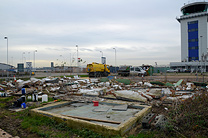
The engineering team have also had to concentrate much of their efforts on crating up all of the Trust's spares ready for the move, as well as preparing the new building to receive them. In a major operation during the final weeks of September and early October 2011 various hired vehicles, borrowed vans and volunteer vehicles made repeat trips from the airport to the farm location until the move was complete. The old workshop, which was in use during the war at the then RAF Rochford, was demolished in early December. The area will soon be lost entirely to car parking space.
The engineering team have been under tremendous pressure but have responded superbly. Work towards 'Return to Power' has continued when possible, including giving much of the upper surfaces of the Vulcan a repaint in carefully researched authentic colours and the refitting of larger items such as the refurbished counterpoise plate illustrated below.
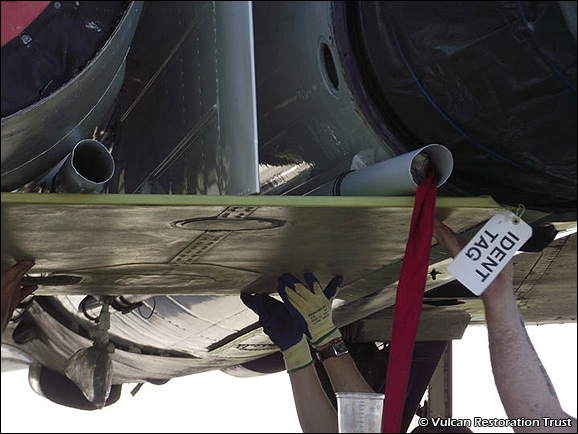
XL426 is out of harm's way, for the time being, on her pan near the Alpha 24 hold but it is likely that she too will eventually have to move to a new home elsewhere on the airport. The airport management have though made assurances that XL426 is very welcome at Southend and will help towards allocating an alternative location. In the meantime, we hope that enthusiasts and the local public can continue to support us through these challenging times.
On 19 December 2011 a small group of Trust members gathered for a drink to honour the twenty-fifth anniversary of XL426's arrival at Southend.
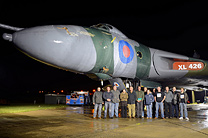
Following her final appearance with the Vulcan Display Flight (VDF) in June 1984, XL426 was offered up for sale. Initial interest from a French consortium fell through and XL426 was purchased by Roy Jacobsen. Two years earlier Mr Jacobsen had bought Vulcan XM655, which had been delivered to Wellesbourne Mountford airfield, and XL426 was to form part of Jacobsen's ambitious but ultimately abortive Vulcan Memorial Flight project.XL426 was flown to Southend on 19 December 1986from RAF Scampton where she had been parked-up since the summer whilst the runway at the VDF base at RAF Waddington was resurfaced. The crew for the delivery flight comprised: Squadron Leader Paul Millikin (captain); Squadron Leader Neil McDougall (co-pilot); Squadron Leader Ken Denman (air electronics officer); Squadron Leader Dave Moore (navigator radar), and; Squadron Leader Ray Leach (navigator plotter). Chief Tech Dave Thorpe (crew chief) was also on board for the flight.
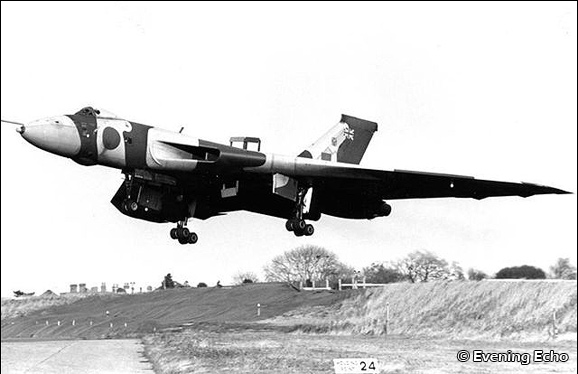
Vulcan XL426 arriving at Southend Airport back in 1986
In July 1987 XL426 was placed on the civil register as G-VJET. However plans to return her to airworthy condition fell through and she remained dormant at Southend. XL426 was threatened with the scrap man's torch in 1993 when the then outgoing management of Southend Airport sought to recover the parking debt run-up since the Vulcan's arrival. However the Vulcan Memorial Flight Supporters Club offered to pay off part of the debt providing Jacobsen passed the ownership of XL426 to the club and the airport agreed to lift the threat of scrapping. A deal was agreed and the supporters club became owners in July 1993. Shortly after the club re-constituted itself as the Vulcan Restoration Trust and the rest, as they say, is history...
Our endeavours to finance the continued existence of the Trust and XL426 into the future include holding fund raising events and our Christmas Event and Buffet was by all accounts one of the most enjoyable yet, with our guest speaker Rod Dean on great form.
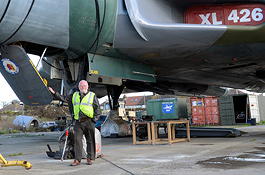
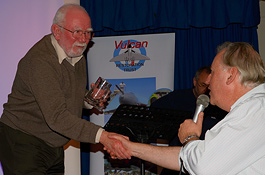
Above: Our guest speaker meets the Vulcan and the VRT members at Southend. Both images © Phil Whalley.
Rod's presentation included amazing photographs and entertaining anecdotes from his service career flying Hawker Hunters with the RAF and in Oman, as well as his earlier training period and more recent display flying. The event was very popular and the tickets sold out in a very short time. Please keep an eye out for our events through 2012 on the Vulcan Restoration Trust website which is also updated with news and more detailed descriptions of the engineering work in progress.
2011 saw the official launch of the Trust's Facebook page which offers an easily accessible location to stay abreast of the day-to-day happenings within the VRT and the wider Vulcan community. A number of our engineering and organisational team members post their thoughts, photographs and news here, and it gives the public the chance to 'converse' directly with the Trust.
The year ahead will be another interesting but testing year for the VRT. The aircraft is getting nearer to the point at which our Chief Engineer will be able to sign her off as fit for high speed taxiing, but there is still much work to do - work which requires funds. To help us reach that pivotal moment could I ask you all to consider joining the Trust as a member. Memberships can be processed online on the VRT website or by post, and are a major source of the Trust's income. We hope that once again we will be able to offer enthusiasts the chance to witness a Vulcan howling on the runway ready for take-off, and even though XL426 won't be able to emulate the exploits of XH558 over recent years by taking to the skies, that such a sight is one worthy of donating towards.
Visit our forums to comment on this post.
Welcome Visitors
Friday 17th June 2011
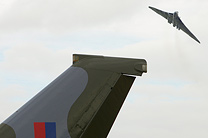
A spectacular reunion took place at Southend airport on Saturday 28 May as two ex-RAF bombers met for the first time in twenty-five years. When the RAF disposed of their Vulcan bombers two aircraft were kept on to display at airshows and events around the UK. The VRT's XL426 was the first of the two to be used for this purpose, until being sold off to a private individual who arranged with the RAF to fly it in to Southend airport on 19 December 1986 - making 2011 its 25th anniversary at Southend. Vulcan XH558 took over the duties as the RAF's air display aircraft until it too was sold off, being delivered to Bruntingthorpe on 23 March 1993, eventually then returning to flight in 2007. In each of the following three seasons XH558 has not been ready to fly as early in the season as May through engineering or finance issues. This year though it was ready in time to be available to appear at the Southend Air Festival, and as soon as it was booked the two teams made moves to allow XH558 to include a flypast over XL426. The VRT have aided the VttST in any way that they can through the long, hard return to flight program of XH558 and the three vigorous passes by the flying Vulcan over XL426 were dedicated to the Southend Vulcan's team, many of whom have been involved since the early days when the '426 was saved from scrapping. It was a truly awe inspiring sight, and much appreciated by the Trust.
We held our combined AGM and 'Enthusiast Event' on 9 April, with Jets Monthly magazine editor Steve Bridgewater as our guest speaker. Having been confounded by the heavy snow falls in December of last year which forced us to cancel our Christmas event, Steve agreed to try again for our April one. In totally contrasting glorious blue skies Steve spent the morning looking around XL426 and the Trust's workshop, and discussing the 'Return to Power' project with our Chief Engineer Matt Lawrence. The Trust was delighted to learn that Steve is collecting information for a forthcoming Vulcan piece in Jets Monthly which was subsequently used in the June issue. Steve was for many years involved with the Classic Flight 'arm' of Air Atlantique, including the acquisition of their Nimrod from the RAF, so was very appreciative of the type and extent of work required to restore and maintain large aircraft. Steve began his talk by listing the many and varied aviation magazines to which he has contributed, although that didn't include the dubious sounding 'Gents Monthly' of which he'd apparently been introduced as editor of at one of his previous events! Steve followed this by showing us some of the photographs that he and the accompanying magazine photographers had captured from around the world whilst producing articles for the various titles, including some stunning images from the Aero GP air races.
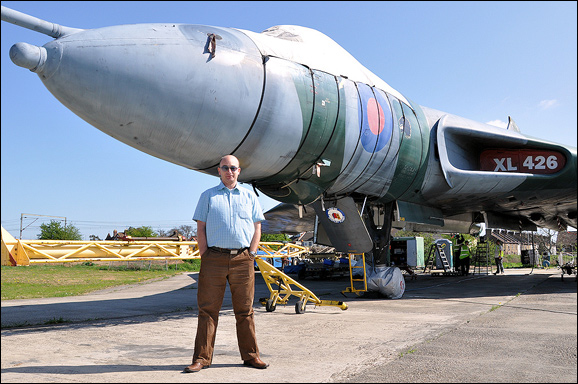
Steve has been collecting photographs that have been taken at airshows since the very first one in this country in 1909, which took place at Doncaster racecourse, and proudly showed us a number of new ones that he had unearthed from various sources, all of which had never been seen before in print. He has a passion for salvaging these old images for posterity - many of which have been found in family albums and 'bottom drawers'. Often taken by non-aviation minded people on a family day out to such events as early Farnborough shows and its predecessor 'Pageants' at RAF Hendon, these images capture a moment in time, and Steve would love to hear from people who might be able to trawl up similar photographs. The second part of Steve's presentation consisted of a number of short films, all continuing the history of airshows theme. Of note were some documentary films, focusing, individually, on three of the Rothmans display pilots from the 1970s. Combining stunning imagery of the pilots going through their routines at shows and over a beautiful rock-faced coastline, with period display items of the day, they highlighted the glamour of the era, and perhaps the more gung-ho attitude of the day. Many of Steve's images and films brought forth gasps of astonishment and sighs for the fond memories of times past from those within the Hall, and we thank him for giving us the opportunity to see them. Steve is planning on publishing a book on the history of airshows, which will include the aforementioned unseen photographs.
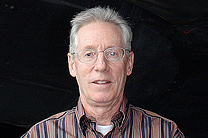
Tickets are now on sale for a talk by Colonel Rich Graham USAF, retired, who is returning for another fundraising evening on behalf of the Vulcan Restoration Trust on Thursday 1 September 2011. The former SR-71 spy plane pilot will talk about the many different aircraft he flew during his career with the United States Air Force. This follows the sell-out talk he gave us in March 2010 which concentrated on the incredible Mach 3 SR-71 'Blackbird'. As well as the SR-71, Colonel Graham will describe what it was like to fly aircraft as diverse as the F-4 Phantom (which he flew in combat during the Vietnam War), the KC-135 Stratotanker and the U-2 spy plane. The talk will take place at the Orsett Hall Hotel, Prince Charles Avenue, Orsett, Essex RM16 3HS, starting at 8.00 p.m. Proceeds from the event will go towards the continued restoration of XL426. Tickets cost £10.00 plus booking fee are now on sale from tickets.avrovulcan.com. Tickets are strictly limited to 100 so don't delay placing your order. In June of 1986 Colonel Graham was selected to be the Vice Wing Commander, 9th Strategic Reconnaissance Wing (SRW), Beale AFB, California. In that capacity, he was able to fly all of the wing's aircraft: the U-2, T-38, KC-135Q, and SR-71.During the 1980s Detachment 4 of the 9th SRW operated from RAF Mildenhall using a small number of SR-71 and U-2 aircraft. From here these high flying aircraft carried out reconnaissance and information gathering missions over Soviet Bloc countries, and other 'hot spots' such as Libya and the Middle East. In June of 1987 Colonel Graham was selected to become the Wing Commander of the 9th SRW, where he remained until November 1988. As the Wing Commander, he was responsible for 10,000 personnel and their dependents on base, over 85 Air Force aircraft deployed around the globe, and a base of 22,000 acres in northern California. He was assigned to the 14th Air Division, Beale AFB, until he retired on 30 September 1989. We are very grateful that Col. Graham has found time in his busy schedule for the return visit.
It was at the Orsett Hall that we welcomed our first visitors of 2011, that being Sqn. Ldr. Jeff Hesketh of the BBMF, who represented the current RAF's Coningsby based collection of historic Second World War aircraft and crews, whilst journalist and author Jarrod Cotter continued the evening's entertainment with his thoroughly researched history on the Flight's formative years, including the original aircraft and their Nomadic early operational records. Jeff was a navigator on the Flight's Lancaster and Dakota for many years - a position of great responsibility. Using just a map and a stopwatch, and often 'aiming' for a minor navigational feature such as a crossroads with a few people and some parked cars, it was a priority that he placed his aircraft or the formation perfectly on track and precisely on time. He recounted just such a tasking to illustrate the difficulty of the job. Although he was confident that they had thirty seconds straight ahead to run to the event they were due to appear at, the Lancaster pilot indicated to Jeff that he thought he could see the target off to one side. They continued on Jeff's planned route, and were perfectly on time and location for the event being held below. It transpired that the pilot had spotted a nearby boot sale!
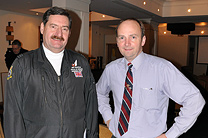
Jeff's presentation included detailed descriptions of each of the aircraft currently flown by the BBMF, illustrated with some very special photographs and audio-visual sequences, culminating in very well produced, multi-angle video of a display by the flight which included air-to-air footage. Jeff was keen to point out that the highlight for many crew members is the interaction with the wartime veterans who they meet whilst on the Flight. Most of the crews are volunteers, and give up the majority of weekends from April to October each year displaying at airshows and other events around the UK and Europe, as well as memorial dedications and ceremonial appearances.
It is hard to imagine that the Flight could be anything but an obvious post-war memorial to the sacrifices made by so many during theconflictr, but Jarrod's presentation which followed illustrated the problematical and sometimes tenuous story of how the BBMF came to fruition. Formed in 1957 and originally known as the Historic Aircraft Flight, it was based at Biggin Hill flying the final, late mark PR Spitfires in RAF service. They found themselves being moved around various RAF stations and relying on volunteers for servicing, and apparently unwanted by the bases at which they were housed. Jarrod explained how some more airworthy Spitfires were let go in favour of fighters slightly more applicable to the era, but suffering even more from serviceability issues. The Flight managed to survive through further location and aircraft changes until their importance to the history of the RAF's role in the wartime battles was more appreciated, and a permanent basing at RAF Coningsby in Lincolnshire deemed worthy. As the Flight's fiftieth anniversary loomed, Jarrod was approached to put together a history of the Flight for a book. He soon found that information and material from the early years of the HAF was scarce, necessitating visits to surviving members or relatives to record memories, and hunt down log books and photographs - some of which Jarrod used to illustrate his presentation. Those original and early HAF member Spitfires were seen to be spread throughout the globe, as new aircraft joined - including of course a pair of Hurricanes, the Lancaster and Dakota, and the title of the team changed to the Battle of Britain Memorial Flight. We must thank both Jeff and Jarrod for such an entertaining and informative evening, and the large number of guests that clearly enjoyed their visit to Orsett, helping fund the continued preservation work on XL426.
One more 'Visit' is imminent, as this Sunday 19 June - Father's Day - we are once again hoping that the public will 'Visit the Vulcan'. Gates open at 10am. Full details on the Trust's website at www.avrovulcan.com All are welcome. XL426 is in the middle of her third re-paint since being at Southend, and this and the other work in progress should make an interesting sight. See you there!
Visit our forums to comment on this post.
Battling for Britain
Sunday, 19th December 2010
It has been a long time since the last update, but that doesn't mean that the Trust has been idle. Far from it in fact, as the engineering team have made great progress on the extensive projects involved with the 'Return to Power' program. A number of large structural items have been re-skinned and painted ready for re-fitting to XL426 at some point in the future, and many sets of wheels and brake units - known as heat packs - are now also stored awaiting their turn. The largest item that the team have attempted to restore, the barn-door sized port in-board elevon, has made great progress. The elevon is built up from extremely complex pressings, the copying of which has been a most testing job for the team - but it is a test that they have been equal to. For the second time in 2010 the engineering team have also recently been on 'snow alert' duties, being on hand to clear the large wing areas of the heavy white stuff. It is a known issue with the large delta winged bomber that if an amount of snow is allowed to build up then there is a danger of the aircraft tipping on its tail, as sadly illustrated by the fate of XL319 at Sunderland.
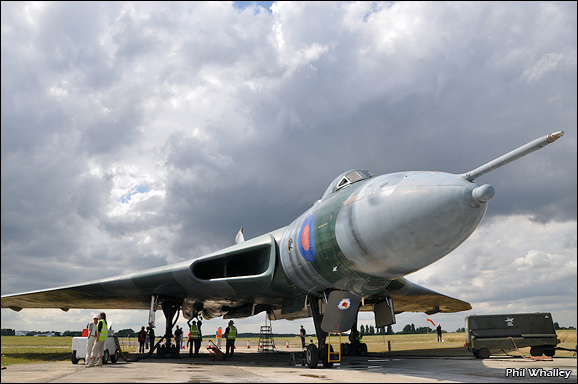
The recent falls of snow also put paid to our Christmas Enthusiast Event, which would have been our final fundraising event of the year. With the Trust being partly reliant on such events for our income, this was a sad but understandable decision that had to be made. Our guest speaker was to be Stephen Bridgewater, commercial director of the Air Atlantique Classic Flight, who has kindly offered to make himself available for a revised date in the future, so please keep an eye open for news on that. Tickets are currently available for our next event, titled a 'Battle of Britain Memorial Flight Evening', to be held on 26 January 2011 at the Orsett Hall, near Grays, Essex, just off the M25. Squadron Leader Jeff Hesketh, who has recently retired as a navigator on the Flight's Lancaster and Dakota, will be speaking about the work of the Flight and how it operates and flies its iconic aircraft. As an added bonus, Jeff will be joined by Jarrod Cotter, aviation author and soon to be editor of Aeroplane magazine. Jarrod is a prolific aviation writer whose titles include the Avro Lancaster Owners' Workshop Manual, published by Haynes, and The Battle of Britain Memorial Flight: 50 Years of Flying. Jarrod will be speaking about the history of the Flight. Doors open at 7.15 p.m. for an 8.00 p.m. start to what promises to be an exciting evening for all aviation enthusiasts. A licensed bar selling light refreshments will be available and a selection of souvenirs will also be on sale.
Advance tickets are available on-line price £10.00 per person plus booking fee from the Vulcan Restoration Trust website.
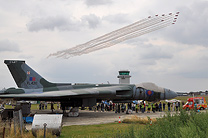
Our other events through twenty-ten went as planned, with only one minor hiccup as far as possible additional income was concerned. We'd been informed of the Red Arrows appearance at our August 'Visit the Vulcan' day in plenty of time to advertise it to the public, which I'm sure would have helped swell the crowd on the day, until the entire Hawk fleet was grounded with an ejection seat issue. We only received final confirmation with a few days to go, but the image of the Reds flying over XL426 did give us an opportunity for some useful after-event press coverage. Another highlight was the visit as our April guest speaker of Richard Noble (see below), famed for his involvement in successful land speed record attempts, but also known for involvement in aviation projects and as a champion of the UK's struggling engineering traditions. We hope to be able to continue this trend of top entertainment for the visiting public, to which our members get priority. They also get exclusive access to members-only events, such as high power engine runs as in July of this year, and that which we are planning for 2011. Please consider joining the Trust as a way of ensuring the continued well- being of XL426 as well as enjoying the benefits of membership. AvroVulcan.com has the details.
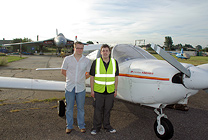
An unusual and painfully early visitor to XL426 in July was young pilot Jonathan Paris who embarked on a 'Dawn to Dusk' flight, aiming to visit or overfly as many of the UK's Vulcan population as possible in one day, commencing from Southend at 06:30. With RAF Waddington's airspace restricted due to arrivals and practice displays for the weekend's airshow, and the fluid situation regarding the location of The Vulcan Operating Company's XH558, this and XM607 had to be removed as 'targets'. XJ823 also eluded them with the cloud base over Carlisle being too low, but they did manage to get to Durham Tees Valley Airport, overhead Newark Air Museum, East Midlands Airport, RAF Cosford, Wellesbourne Mountford Airfield, Coventry Airport, and Norwich Airport, before returning to Southend. Jonathan's intention was to gain media attention for the preserved Vulcans which was a welcome offer from him, and we congratulate him on his efforts. The Vulcan is an iconic British aircraft, and the VRT will battle to ensure XL426's continued good health - please help if you can. Thank you.
Visit our forums to comment on this post.
A Noble Ambition
Friday, 16th April 2010
Former World Land Speed Record holder and project leader of the current attempt to push that record through the 1000mph barrier, Richard Noble OBE, visited us on Saturday 10 April, to give a presentation on his incredible career as a champion of British engineering at our AGM at the Hawkwell Village Hall. Richard's attempts at the Land Speed Records, all of which have been ultimately successful, have each been achieved by a very small, highly motivated team, working on a shoestring budget - very much like the VRT! The demands of the current project, BLOODHOUND SSC (Supersonic car), have required a vastly different approach to overcome its incredibly complex engineering and scientific hurdles, to push a land based car through 1000mph. A speed which is even greater than any high speed jet aircraft can achieve at low level! There is a vast shortage in the UK of skilled engineers, so Richard's plan has been not only to engage the country's education system in the project, but to attempt to encourage the young people of today to fill that skills void for the future. The Thatcherite eighties created an economy that shunned the UK's traditional manufacturing legacy, in favour of one dependent on the fickle financial markets. Subsequent governments have shown little will to reverse that trend, creating a void which has left the country bereft of inspiring technological projects, and into its current economic mess.
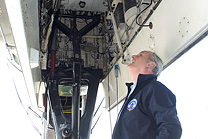
The BLOODHOUND SSC vehicle has a number of propulsion systems, some of which have their roots in aviation - including a direct link to the Vulcan. In the middle of the BLOODHOUND SSC is the MCT V12 800 bhp race engine which doubles as an APU, delivering hydraulic power as needed, starting the Eurojet EJ200 and pumping the High Test Peroxide (HTP) through to the Falcon rocket - a method used on the V-Force Blue Steel missile. The pump has to move a ton of HTP through to the rocket catalyst in 22 seconds and at 1200 psi. The EJ200 is of course the engine that powers the Typhoon, although these are early development engines with very few hours on them. Despite its unsurpassed power to weight ratio the EJ200 is not capable of taking the SSC to the speeds that the team are aiming for, hence the rocket which will take over to push it through 1000mph. Richard's narrative in describing his experiences was both highly instructive and entertaining, and we thank him for coming to visit us.
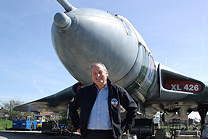
Before giving his presentation, Richard visited XL426 at the airport. He was impressed by the work being carried out by the Trust's engineering team, who all give up their time voluntarily. Most of the team come from non-engineering backgrounds but have learnt 'on the job', creating work of the highest quality which will help preserve this important icon from the Cold War well into the future, which itself will hopefully inspire young people to embark on a career in the aerospace industry. We will be holding an open day on 18 April to enable the visiting public to view the work that the team have achieved, and to see for themselves the engineering marvel that is the Avro Vulcan. See avrovulcan.com for details.
Visit our forums to comment on this post.
Flying High
Friday, 12th March 2010
On Wednesday 3 March the Trust was delighted to host a talk by Col. Rich Graham, USAF (Ret'd), in a new style of venture, to help raise funds towards the continued preservation of XL426. One of the small band of pilots selected to fly the Lockheed SR-71 Blackbird 'spy plane', Col. Graham enthralled the sell-out audience at the Orsett Hall Hotel, Essex, with tales of his experiences flying this iconic aircraft.
Using photographs and diagrams, which would have been top secret at the time, Col. Graham took the audience through the thorough pre-flight procedures necessary to ensure a safe and successful mission. The aircraft's two-man crew would be entering a highly dangerous environment - the Blackbird regularly flew at heights of 70 - 80,000 feet - and the defensive threats from those countries that didn't wish to be photographed also had to be taken into account!
Col. Graham used the example of a mission from the Blackbird detachment based at RAF Mildenhall, to photograph Soviet Union's Northern Fleet's base at Murmansk. He explained how shortly after take-off the Blackbird would refuel from a KC-135 tanker over the North Sea before continuing around the top of Norway towards Murmansk. The Blackbird would not overfly the Soviet Union but would fly a 'sweep' over the Barents Sea, enabling it to gather information on military installations hundreds of miles inside Soviet territory. Frequent quotes of the speeds and altitudes attained by the Blackbird on such missions demonstrated how special the aircraft was, and how unique the whole programme and its operations were in the history of aviation.
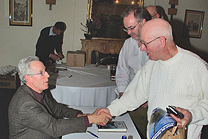
Col. Graham told us of how he would look down from 80,000 feet, and at speeds beyond Mach 3, at the contrails of fighter jets scrambling to intercept him, but unable to get anywhere near. The extreme speeds that the Blackbird would fly created equally extreme heat on the external surfaces of the airframe. Col Graham explained how he turned this to his advantage when the time came to eat an otherwise unpalatable 'meal' from a tube (made by US baby food manufacturer Gerber). He recalled how he would place the tube against the cockpit glazing, where the temperature of around 800 degrees Fahrenheit would quickly heat it up and turn it into something that more closely resembled proper food!
Although the SR-71s were based at Beale AFB in the United States, all operational missions were flown by detachments at Kadena AFB in Japan, and Mildenhall. The Suffolk base was a favourite amongst the crews, and Col. Graham recited a story involving three British maids who looked after their accommodation on base. A mission would normally require a 3am wake-up call for a 6am departure. Often the mission would be 'scrubbed' for one reason or another, allowing the crews to return to their quarters. Having such unsociable hours, they took the chance to partake in some alcoholic beverages and 'party'. When the maids arrived and found the revelry in progress, and not being 'in the loop' on the flying schedules, they assumed that these Yanks had been on an all night binge!
Col. Graham has written three books on his experiences whilst serving his country, all of which were for sale on the night, and which he was happy to sign. He was also pleased to chat and answer questions during what was a very enjoyable evening's entertainment. The Orsett Hall Hotel has recently re-opened after the fire that destroyed it in 2006 and its newly refurbished Whitmore Suite provided a very fine setting for Col Graham's talk.
The Trust would like to thank Col. Graham for agreeing to be our guest speaker on this special night. In turn he thanked us for making him and his wife, Pat, so welcome, and wished us well with our continued efforts towards preserving XL426.
We will be looking into the possibilities of holding similar events in the future as a means of raising funds for the Trust. Please keep looking in on avrovulcan.com and UKAR for the latest news.
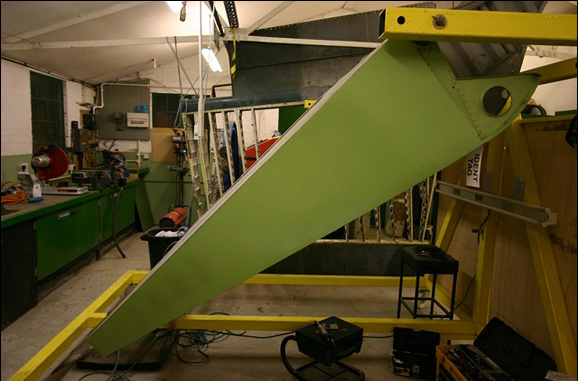
Primer painted elevon
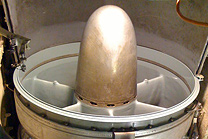
Meanwhile on the Vulcan, progress during February and March has centred on the elevon rebuild and the reassembly of the engine intakes. The massive elevon which is in the jig that takes up much of the team's workshop continues to attract much attention. New channels have been made and dry fitted to the elevon ribs with skin pins. Some areas of cleaned and treated skin have been primer painted. Also, during the reassembly of the intakes on all four engines further work was deemed advantageous. The hydraulic pumps are being replaced on numbers 2 and 3 engines with new pumps, due to the current pumps over-pressuring the system. The first to be changed is No 3, with No 2 to follow. General decorroding and repainting has also been carried out as seen fit. The team are beginning to thaw out from their winter's work on the Vulcan. Unlike XL319's custodians 'oop north', the Southend team heeded the weather warnings and tied the nose down, and swept off the snow to avoid any embarrassing incidents!
Now that the 2010 is well underway, we are looking forward to our year's events. The public's first chance to see XL426 is fast approaching, so please keep 18 April free to come and inspect the work the team have been carrying out, in all weathers, and give the team some well deserved support. Thank you.
Visit our forums to comment on this post.
Merry Olympus and a Vulcan New Year!
Thursday, 24th December 2009
At this time of year people tend to look back over the past 12 months and reflect on what they have achieved in 2009 and to be honest we're no different. I want to take this opportunity, in the last blog entry of the year, to do just that and also to look forward to what promises to be an excellent 2010 for the VRT.
Last year saw a few changes for the Trust, possibly the most significant being at the beginning of the year when our chairman, Kevin Packard, decided to step down as a trustee and from the position he has held for more than 8 years. This was allegedly to spend more time with family and get those jobs done around the house etc, however we do seem to see a lot more of him down at the aeroplane now he hasn't got all that bureaucracy to deal with! This could have been a time of turmoil within the Trust with no chairman to guide us through, but our current treasurer Keith Harvey stepped into the firing line and took of the role as interim chairman and has done a superb job managing the changes we faced. I think the entire VRT would send thanks to both these gentlemen, Kev for his past endeavours and Keith for those yet to come.
It was around this time that I got stuck with…..err, volunteered to take over as membership secretary for the Trust. Our previous secretary Marion was moving from the area and it was not feasible to conduct the job from such a distance. But it's a job that has its advantages and I'm very happy to do it and I can still play with the aeroplane at weekends.

Merry Christmas from the Vulcan Restoration Trust
It was also a big year for progress on the aeroplane and the Return To Power programme. After we took delivery of some flying control surfaces from Bruntingthorpe the engineering team have been able to make huge strides in restoring the No.4 elevon. It is now at a stage where the majority of the internal structure has been renovated and then it can be re-skinned ready for putting back onto the wing. Many other areas have and are continuing to receive attention, including the cockpit, wheels, engines, intakes and external structures. Whilst Return To Power still has a long way to go before it is actually completed, 2009 was a positive stride in the right direction and has given us something to build on for the next 12 months.
The engines had the internal structure checked for corrosion during the autumn and all seemed to be fine in that area, so hopefully they will last us a good few years yet. It is hoped that we can get the aeroplane on a taxy run during 2010, even if it's a slow one, it will be brilliant to see and hear her moving under power again. Matt Lawrence, Paul Hartrup and the team having done an excellent job looking after XL426 and have the thanks and support of the entire trust to carry on into the new year. You can see some of the progress reports right here on UKAR in the 'oldies' section.
On the events side, we held some very well attended Visit the Vulcan days at Southend Airport throughout the summer. These serve to generate much-needed funds for us and to give both members and the public a chance to see a Vulcan up close and personal as it were. For the regular visitors it also gives them an opportunity to see the progress being made on the aeroplane. If you didn't get to one last year then do try and make the time to pop down to the seaside for the day and Visit a Vulcan while you're there. Check the website for the 2010 dates, avrovulcan.com you'll certainly enjoy it.
The new VRT sales stand certainly made itself useful during the year both at our own events and on a few road trips such as the Waddington show. For the first time in eight years we managed to get to 2 events on the same day, with a Visit the Vulcan day clashing with the Damyns Hall show. Without the new stand this would certainly have not been possible. As a result of this Andy Vass and the events teams are planning to get the VRT into several other events and shows during the next year, again details can be found on the website of where the VRT stand can found, do come and say a quick hello, because I'm sure many UKARians will attending the same shows we are.
The biggest single change for the VRT came in December, with the publication of our members' magazine 'Vulcan News'. Dave Griffiths has long hankered to have VN produced in full colour and in the last few weeks this ambition has finally been realised. Having seen the finished magazine, I can say it is a work of art in its own right; trust members will receive their copy before the end of 2009, if you are not yet a member then this is another reason why you should be. Membership details can be found on the website; for a stunning magazine, access to a Vulcan and some very special events it is worth every penny.
2009 finished up in some style for the VRT with our members' event held in Hawkwell. As a guest speaker, we were honoured to host Jonathon Whaley, more recently known on the airshow circuit as the pilot of the understated Hawker Hunter 'Miss Demeanour'. However, there is lot more to this gentleman than just 'that' paint scheme, Jonathon enthralled over 100 people with tales of flying, film work and his times in the Fleet Air Arm, so huge thank you goes to him for his time and effort in entertaining us.
So after waffling on for an age, all that is left is to wish all users of UKAR a very happy holiday season and a safe, peaceful and prosperous 2010 from myself, Steve Barnes, and fellow bloggers Phil Whalley, Paul Hartrup and everyone at the VRT. We have a lot to look forward too in 2010 and we'll be telling you all about it right here.
Visit our forums to comment on this post.
Turkey and Flapjacks!
Friday, 20th November 2009
The Vulcan Restoration Trust are delighted to welcome Jonathon 'Flapjack' Whaley to speak at our Christmas Enthusiast Event and Buffet on Saturday 5 December 2009.
Jonathon Whaley started his flying career by joining the Royal Navy in 1965 at the age of 17. After gaining his 'Wings' he moved on to Advanced Flying Training on Hawker Hunters at RNAS Brawdy in South Wales. His love of the Hunter had begun.
His Operational Flying Training was carried out at RNAS Yeovilton, flying the Sea Vixen FAW2, followed by his first front line appointment to 899 Sqn, embarked on HMS Eagle. It was during his time on the Sea Vixen that he gained his nickname 'Flapjack', having overstressed the aircraft's flaps during 'high g' manoeuvring, on more than one occasion. He also lost part of a canopy during a catapult launch. In all these incidents he managed to bring the aircraft safely back on deck.
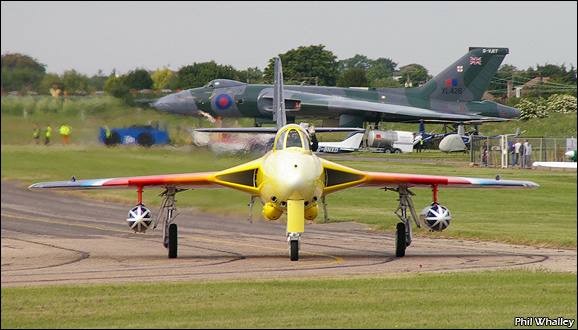
Jonathon arriving for the 2007 Southend Airshow
1973 saw Jonathon leave the Navy for an engineering career. He started competing in and teaching competition aerobatics. During this time he also started Airshow, TV and film flying. Amongst his film and TV credits are "Bugs", "Born to Ride", "Indiana Jones and the Last Crusade" and "The Mummy". Jonathon's logbook includes over 120 aircraft types from a Bleriot to the Russian MiG 29 and Sukhoi 27 Flanker. Display aircraft include the Bleriot, Manning Flanders, Fokker Eindecker, Sopwith Camel, Morane Saulnier ”N" Type and 230, Stampe, Yak11, Fiat G46, Spitfire and Hawker Hunter.
His company, Heritage Aviation Developments Ltd, was set up in the late 1990s and acquired a single seat ex-Swiss Air Force Hunter J-4104. Registered as G-PSST and named Miss Demeanour, the Hunter has famously received a gaudy colour scheme, and delights airshow crowds wherever she appears.
Jonathon will be recounting his life in aviation for us during the event, which I'm sure will be a enthralling.
The Event will take place at the Hawkwell Village Hall, Main Road, Hockley, Essex, SS5 4EH and starts at 12:00 noon, and finishes at 17:00. The event is advance ticket only.
Tickets cost £10 each for adults, and £5 each for children aged 5 to 15. Under 5s are free. Included in the price is a buffet lunch, whilst teas and coffees are also available.
Tickets can be ordered by post from the following address:
VRT Christmas Buffet,
Treetops,
Woodham Road,
Battlesbridge,
Essex,
SS11 7QW
Cheques should be made payable to VRT Enterprises Limited. Please include a SAE with your application. The closing date for application is 28 November.
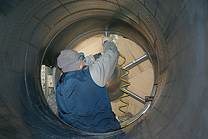
Work on 'Return to Power' has continued apace over the last few weekends, with attention being focused on preparing further sets of reconditioned wheels, de-corroding around the flying control surface bays, and also around the engine intake areas. After blanking off the front of the actual engine , Colin Cockerton can be seen applying a mini sand blaster to the necessary areas. These will soon be chemically treated, undercoated and painted. Similarly the areas now accessible after the removal of the massive number four elevon will be treated to plenty of TLC, so that once the restored elevon and its associated control units are ready for refitting, then the whole area will be as good as new and can look forward to many years of service.
For ways in which you can help towards the necessary costs of our 'Return to Power' program and all other aspects of our fundraising, please visit AvroVulcan.com
Visit our forums to comment on this post.
A Noise to Re-Member
Friday, 23rd October 2009
As a slight change to the normal format of our members' events the Trust elected not to employ a guest speaker as such for this occasion. We thought we'd let the aeroplane and the engineering work speak for itself. It has been a plan for while to show the members of the trust what we are up to down at the airport and this was an opportunity to restructure the day slightly to allow this.
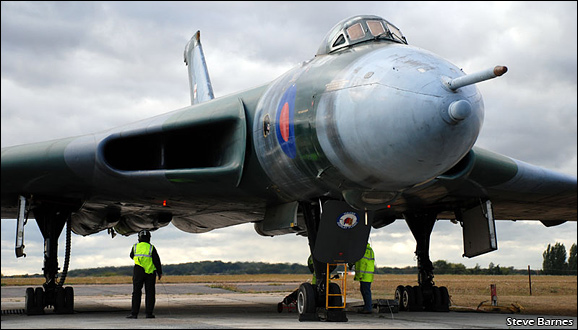
So the day starts as normal with the members meeting at Hawkwell Village Hall, where refreshments are topped up on before the obligatory announcements have to be made by our own team commentator, Dave Griff. A standard event would then consist of being entertained by one of the guest speakers that the Trust has been honoured to have been graced by their presence at past meetings. The likes of Martin Withers, Ken Ellis and Wing Co. Peter West, to name but a few, have all stepped into the breech previously. But this was no ordinary event; this time around the gathered audience was treated to a brilliant documentary on the last days of the Vulcan with 617 Squadron after being briefed on the remainder of the days programme, including a raffle to take the #2 seat up front for the engine run and this was subsequently won by Mr. John Vass, and I think he's probably still wearing the grin now!
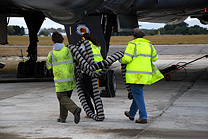
So it was then all down to the airport for part two of the day. A tour of the workshop facilities and the ongoing works within it was the first order of business before the small but enthusiastic crowd was escorted airside toward the pan. The engineering team had been working their socks off getting the aeroplane prepared for her starring role in the days events, their task made no less easy by the horrendous wind coming straight up the jet pipes!
Once the safety briefings had been completed and ear defenders dished out liberally to all that felt the need, the crew for the engine run got aboard, including our lucky raffle winner. Matt Lawrence, our chief engineer taking the left hand seat with Martin White acting as AEO for the duration, ably assisted by another UKAR regular and blogger, Paul Hartrup acting as crew chief, controlling things on the ground.
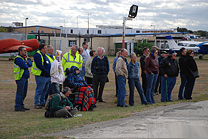
So with everything looking good it was time to get the proceedings underway. The Airstart unit was connected up to '426 and then run to warm up to provide enough air to turn over the mighty Olympus 201 engines. About 5 minutes into this, disaster struck when the hose from the Airstart unit split away from the aircraft connection. The sighs from the crowd were almost as loud as the Airstart itself! However, this was the VRT engineering team and these boys and girls don't do disappointment. With a lightness of foot I not witnessed previously, the hose from our own Airstart unit was dismantled, run, yes run, across the pan and fitted to the borrowed unit with a speed that would have impressed Usain Bolt.
The drama now over it was back to the business of running up 4 of one of Rolls Royce's finest creations. All went to plan and the engines ran and sounded brilliantly, a perfect end to a great afternoon's entertainment. Hopefully all those present to witness this all to rare event went away with a broad smile, I certainly did!
Now we have to follow this up with an even more entertaining afternoon for the Xmas 'do'! With the guest speaker lined up for this one I think we might just manage it, check the VRT website for details.
Steve Barnes
Visit our forums to comment on this post.
A 'Visit the Vulcan' Day to Remember
Friday, 9th October 2009
Well the sun was shining which was as good as we could hope for when the day started. Having completed most of the set up work the day before, the early starters among the volunteer force at the airport only had the finishing touches to make good before the gates opened at 10am. It can be a little disheartening putting in all the effort to set up the event and no one turns up! The nice weather is always a bonus for us because hopefully that means we'll be in for a busy day with the visitors.
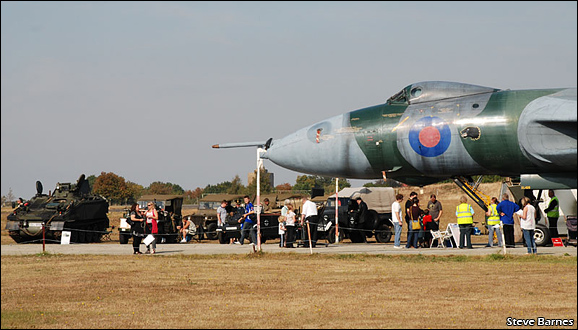
If you have not managed to get to one of these events yet then please do try and fit one in when they come round again. They are very informal and where else can you get up close and personal with a 'live' Vulcan. The days serve not only as chance to see the aeroplane but also to see the progress being made by the engineering team on the many on going projects in the 'return to power' programme. From the Trust's side it is also a valuable tool in raising much needed funds to continue looking after XL426 and keeping her safe for future generations to enjoy.
Wherever possible we try and get other attractions alongside the aeroplane and this occasion was again well supported. Nigel Moss returned with his excellent 1976 Alvis Spartan armoured personnel carrier. He was joined by no fewer than eight additional military vehicles brought along by various members of the Essex Military Vehicle Trust, including an Austin Champ, several Willys Jeeps and a contingent of Germans.
Huge thanks must go to all of these guys for showing their support and turning out in such force also for raising additional funds for us with donations for having the public climb all over their vehicles.
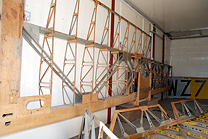
As an additional item for this event we also had an aircraft static display, which although slightly smaller than RIAT still featured a couple of rare birds. These were a Slingsby T31 single seat powered glider G-BVFS and a Slingsby Grasshopper primary glider, both of which are owned by long time Trust member and engineer Steve Williams. Both airframes are under restoration to flying condition by Steve and their appearance was much appreciated.
From the outset of the gates opening we were lucky enough to have many people eager to see what we have been up to with the aeroplane and it was busy from start. Both the vehicles and particularly the cockpit visits were proving popular attractions and these were soon being booked up until well into the afternoon. With many of the events and engineering team volunteers on hand to answer questions many a curiosity was satisfied with some even being about the Vulcan, but that's a story for a different time!!
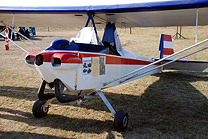
Our stunning new events stand, in its first full season of operation, was reporting brisk business throughout the day with our new(ish) baseball caps proving very popular in the sunny conditions. With this and our marquee selling second hand books and magazines, much needed income was generated throughout the day. More importantly, especially from my point of view, several new members to the VRT signed up on the day to become supporters of XL426.
The members are the lifeblood of our Vulcan and all of the subscriptions go towards her upkeep. The bonus for anyone joining up now is they will get free entry to all of next years Visit the Vulcan days as the membership will expire shortly after the last one. So not only do you get 2 issues of probably the best Vulcan magazine on the planet and regular updates you also get to see her in the 'flesh' several times a year. If you missed out on joining on the day, you can still do so on-line via our website.
So as the sun set on the last of this years VtV days we had just about finished packing away all the kit. I must say a huge thank you to all of the team who put such a massive effort in to make the day so successful and to the generosity of all those who parted with the hard earned cash whilst they were there. Better start planning for next year now! But we still have the Members Event on Saturday 3rd October to produce yet!
Steve Barnes
Visit our forums to comment on this post.
In Volunteers We Trust
Friday, 18th September 2009
Welcome to our VRT blog, during which we'll aim to keep UKAR readers updated on all things related to XL426, and the Trust as a whole.
The Avro Vulcan was designed as a long-range bomber to replace the famous wartime Lancaster in the post-war Royal Air Force. The first example flew in 1952 and the aircraft began entering service in 1956. When it first flew, its wingspan of over 100 feet meant it was the largest delta-wing aircraft ever built, a record later beaten by Concorde. Designed to fly at extreme height and armed with nuclear weapons, the Vulcan was the spearhead of the British deterrent force during the 1960's era Cold War. The only time Vulcan's were used in anger was during the South Atlantic conflict in 1982 when they flew the longest bombing missions in history at that time - codenamed Black Buck - dropping high-explosive bombs on the Argentinean-occupied Falkland Islands. The Vulcan ceased flying with the RAF in 1993.
Built in Manchester in 1962, our XL426 served with the RAF for 24 years, being based at Scampton and Waddington in Lincolnshire, with numbers 83, 27, 617 and finally 50 Squadrons. It was part of the nuclear deterrent force and carried the Blue Steel Cruise missile. In 1963 it set an unofficial speed record for flying the North Atlantic of 4 hours and 52 minutes. XL426's final years with the RAF were spent with the Vulcan Display Team, appearing at air displays in Britain, Europe and North America, before being replaced in the VDT by XH558. Retired to Southend Airport in 1986, its buyer intended to continue displaying XL426 at airshows. Not realising the implications, this obviously proved to be beyond his means and abilities, and the Vulcan soon built up parking fees which remained unpaid, threatening its future existence. XL426 was left in open storage - eventually on grass - at the airport, with a strong risk of being reduced to scrap. Here it deteriorated until the nascent Vulcan Restoration Trust (then titled the Vulcan Memorial Flight Supporters Club) took over its ownership in 1993. Over many years the VRT restored the airframe, returning it to taxiing condition, and continue to maintain XL426 in full ground running condition as a tribute to the men and women who designed, built, flew and maintained the Vulcan during its time with the RAF.
The Vulcan Restoration Trust is entirely operated by unpaid volunteers, and financed by public donations. The VRT's engineering team spend every Saturday working on the aircraft in all weathers, performing minor miracles to overcome any problem that the aircraft throws at them. We have built our own pan at the airport, and gathered together an engineering infrastructure to keep our Vulcan alive. The Vulcan is a large - hence expensive - aircraft to 'operate', so demands a great deal from the team. We come from a variety of backgrounds, but all have a passion for the work involved. We would welcome new volunteers for the Trust, especially to the engineering team, and new memberships to support the aircraft financially. Details on how to do this can be found at AvroVulcan.com
A taxi run by XL426 had been a feature of both days of the Southend Airshow at the airport for around ten years. The Trust have decided though, that the time has come for more intensive restoration work to be carried out, involving the removal of major items, and so to temporarily put a halt to taxi runs. A campaign titled 'Return to Power' has commenced with a target to raise £54,000 to cover the costs of the work. To help reach this target the VRT have been holding 'Visit the Vulcan' open days through 2009, at which the public are able to inspect the aircraft and the work so far carried out. Also the public are welcome at the Trust's Enthusiast Events held in Hockley, near Southend, for a small fee payable at the door, at which we aim to attract interesting guest speakers.
Our blogs will keep everybody updated with all these events as they happen, along with previews of up-coming events. Our last 'Visit the Vulcan' day is fast approaching, being on the 27 September, and we have a 'standard' Enthusiast Event on the 3 October, plus the Christmas special on 5 December. Watch this space for news of the guest speakers.

